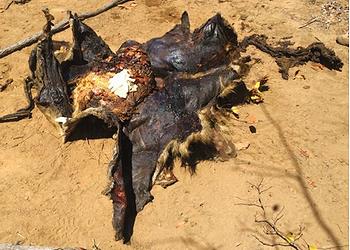
By Don Pinnock
CAPE TOWN, South Africa, October 22, 2016 (ENS) – The ongoing Asian demand for lion bones has led to a wildlife poisoning in the Limpopo National Park, just over the Mozambican border from South Africa’s Kruger National Park.
A mere two kilometers from the Machampane tourist camp, a research team from the Limpopo Transfrontier Predator Project came across the carcasses of two nyala, a warthog and an impala laced with what they describe as a black granular poison.
Lying nearby were the bodies of two lions, 51 vultures, three fish eagles, a yellow-billed kite and a giant eagle owl. There was evidence of a leopard but its body was not found.

Snares had been set around the poisoned carcasses.
The lions had been dismembered, their bones removed, and 22 vultures had been decapitated, their heads presumably to be used for muti. Derived from the Zulu word for tree, muti is a term for traditional medicine across much of southern Africa.
Lions are killed so their bones can be used to make fake aphrodisiacs and traditional medicines. The demand for lion bones is growing in Asia as tigers become scarce.
The research team found the two lions had been carried 200 metres away from the epicenter of the poisoning onto a nearby ridge and butchered. The skins, a portion of the abdomens with significant layer of fat and the intestines were left.
The two male lions were both estimated to be about two years old. All their bones had been removed and meat had been cut into strips, dried and mostly removed.
The Limpopo Transfrontier Predator Project team burned all the poisoned carcasses that remained at the scene.
This is the second poisoning event that has targeted the lion pride in this same area. The first one, in July 2014, killed three adult lions, seven white-backed vultures and a bateleur eagle.
According to the team that discovered the carcasses, “This poisoning is the first time that we have found evidence of lions being targeted for their bones in the park. Considering the prevalence of commercial rhino and elephant poaching in the region over the past five years we are concerned that this event could mark the beginning of large-scale poaching of lions for their bones in the Limpopo National Park.”
Earlier this month, at the Conference of the Parties to the Convention on International Trade in Endangered Species, CITES, nine African nations – Niger, Chad, Côte d’Ivoire, Gabon, Guinea, Mali, Mauritania, Nigeria and Togo – sought to uplist lions to Appendix I, which offers full protection from international trade.
But delegates did not back their attempt at greater protection, and wild lions remain on Appendix II, which allows regulated trade in listed species and their parts.
The Appendix II listing specifies a “zero annual export quota for bones, bone pieces, products, claws, skeletons, skulls and teeth removed from the wild and traded for commercial purposes.”
But, in a compromise move that shocked many conservationists, the CITES delegates allowed the marketing of captive lion bones.
Captive lion breeders escaped the ban, with South Africa only required to submit an annual quota for bone exports from captive breeding facilities.
Will Travers, president of the nonprofit Born Free Foundation, called it an appalling decision that would perpetuate the captive-breeding bone trade.
Conservationists point out that it is impossible to distinguish the bones of captive-bred lions from those of wild lions, leaving the door wide open for laundering of poached animal parts.
{South Africa’s Conservation Action Trust contributed to this report.}
Copyright Environment News Service (ENS) 2016. All rights reserved.
© 2016, Environment News Service. All rights reserved. Content may be quoted only with proper attribution and a direct link to the original article. Full reproduction is prohibited.
